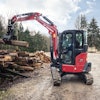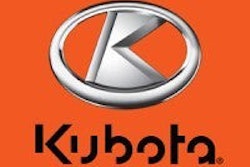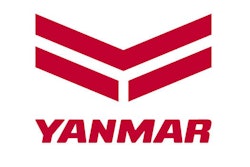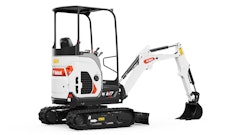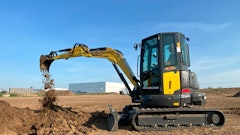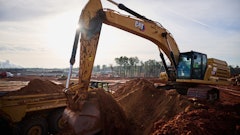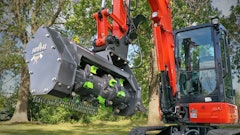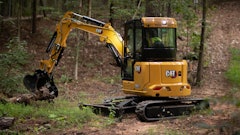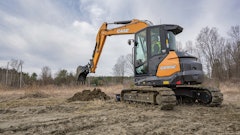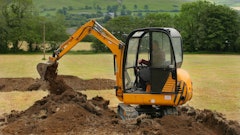
For anyone who has broken up concrete in close quarters using a hand-held jackhammer, there may be no machine more welcome on a jobsite than a compact excavator. Though still viewed by some as an "oversized Tonka toy", those in-the-know consider it an essential part of their demolition team.
"When we introduced our models over 11 years ago, they weren't an accepted product," says Kendall Aldridge, IHI Compact Excavator Sales. "But if we could get a contractor on a machine, and it was a good fit for his application, we couldn't get him off."
The right fit, he explains, is any place where tight quarters restrict access to larger, more traditional-sized demolition machines, or where manual labor is time-consuming, tedious and inefficient. Utility contractors, interior demolition contractors, plumbers and concrete contractors are just a few of the end users who have found these machines invaluable.
An effective replacement
Stories abound about the unique situations where compact excavators have been called in to replace larger equipment or manual labor. This is especially true for smaller models weighing in at less than 3 tons.
Keith Rohrbacker at Kubota cites one example. "The bathroom sewer in one of our city parks needed to be fixed," he recalls. "To break up the concrete, they were using a backhoe equipped with a hammer that they were trying to fit through a window. But they just couldn't get it positioned where they wanted it. Once they got hold of our [1-ton] K008 with a hydraulic breaker, they could drive the entire machine right through the door to get exactly where they needed to be."
John Amorosano, a partner in New York Breaking Co., as well as a Takeuchi dealer, has taken his compact excavators up and down the passenger elevators of downtown Manhattan high-rise buildings. They have also been loaded onto subway trains for demolition work in tunnels or work on rails on subway tracks.
"Since it's only 31 in. wide, it can go through any standard 36-in. door," says Amorosano. "These machines have just been very, very popular here because they're such a convenient size."
David Robles, co-owner of a Texas-based construction firm, agrees. He notes that he has had his Takeuchi compact excavators working less than 15 ft. from an operating table, on the other side of the wall of the ICU at an El Paso hospital. "We had to demo that wall," he recalls. "We drove the machine through the halls. It's only 31 in. wide so it can go anywhere. That's the good thing about these machines."
Robles previously used a skid steer with a hammer. Then about 10 years ago, he purchased his first compact excavator. Today, he owns seven.
"We were doing a lot of openings in floors for elevators. But it was more difficult with the skid steer because it didn't have the reach that an excavator has," Robles explains. "This is just safer and easier. Plus, they are so much faster than manual labor. They can do what four guys can do by hand in a day, and they don't get tired."
It's also easier on his employees. "Breaking concrete by hand is hard on the body," he says. "Guys would have back problems. Now it's just easier."
Well-equipped for demolition
Manufacturers are designing features into compact excavators to enable them to withstand the rigors of demolition tasks.
For example, all Yanmar compact excavators have standard shields, as well as ROPS or FOPS. Hydraulic hoses are positioned inside the boom, where they are protected from potential damage from debris.
Kubota models include reinforced welded steel collars at both ends of the pins, as well as an oil cooler to prevent overheating.
Manufacturers are also incorporating many of the same productivity features as larger excavators, such as independent boom swing, 360° visibility, one- and two-way auxiliary hydraulics, hydraulic quick couplers and, in many cases, zero tailswing.
But some available features are unique to compacts, such as a foldable ROPS for low overhead clearance, and built-in lift points that allow them to be placed in a basement or craned to an upper floor.
Certain models also offer variable-width track systems for easy access through narrow openings.
The hydraulically-controlled undercarriage on Takeuchi's TB108 and TB016 models provides the ability to narrow the track width for better access in tight work areas, then expand it to provide stability, notes Mike Ross, product manager at Takeuchi.
Yanmar's tracks adjust both in and out and up and down independently, says Curt Unger, general sales manager. This provides the ability to level the unit up to a 10° slope.
Another advantage of compacts is the ability to power hand-held hydraulic tools via the excavator hydraulic system. "It used to be you used air hammers that needed a compressor and hoses," says Unger. "Now hydraulic tools have replaced air tools. An excavator can run those tools off the front of the machine so now you don't need any additional compressors and hoses. There's a whole group of equipment that has been eliminated."
Achieving zero tolerance
Because their size makes small compact excavators ideal for indoor applications, exhaust purifiers, or "scrubbers", are available for diesel units.
IHI also offers an electric model for use in areas with zero tolerance for emissions. Its 75-ft. cord plugs into a generator or, with the proper voltage, right into a wall.
"Our electric model is easy to maintain because it doesn't have as many moving parts as a diesel," says Aldridge. "There are no fumes and no emissions. It's a niche product, but for the right contractor, it can pay for itself in one job if it's big enough."
Ohio Concrete Sawing and Drilling in Sylvania, OH, has four IHI electric models. One was recently used to perform demolition for an addition to a mall in nearby Toledo.
"Without these machines, we would have had to do this job by hand," relates Skip Aston, owner, adding that the mall had a zero tolerance level for emissions.
The machines are small enough to fit through a 34-in. doorway. "And they can dig to a depth of 5 ft. That covers most applications we need," Aston notes.
He adds, "I like these machines because they don't get tired. And they're quiet - about the noise level of an electric fan. The only way anyone knows we are around is because they hear the dirt scraping against the bucket."



